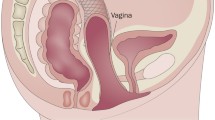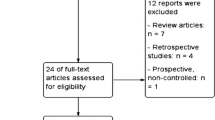Abstract
Robotic-assisted laparoscopy is increasingly used in female pelvic reconstructive surgery to combine the benefits of abdominally placed mesh for prolapse outcomes with the quicker recovery time associated with minimally invasive procedures. Level III data suggest that early outcomes of robotic sacrocolpopexy are similar to those of open sacrocolpopexy. A single randomized trial has provided level I evidence that robotic and laparoscopic approaches to sacrocolpopexy have similar short-term anatomic outcomes, although operating times, postoperative pain, and cost are increased with robotics. Patient satisfaction and long-term outcomes of both robotic and laparoscopic sacrocolpopexy are insufficiently studied despite their widespread use in the treatment of prolapse. Given the high reoperative rates for prolapse repairs, long-term follow-up is essential, and well-designed comparative effectiveness research is needed to evaluate pelvic floor surgery adequately.
Similar content being viewed by others
References
Papers of particular interest, published recently, have been highlighted as: • Of importance
Wu JM, Hundley AF, Fulton RG, ER ER. Forecasting the prevalence of pelvic floor disorders in U.S. women: 2010 to 2050. Obstet Gynecol. 2009;114(6):1278–83.
Luber KM, Boero S, Choe JY. The demographics of pelvic floor disorders: current observations and future projections. Am J Obset Gynecol. 2001;184(7):1496–501. discussion 1501–3.
Olsen AL, Smith VJ, Bergstrom JO, Colling JC, Clark AL. Epidemiology of surgically managed pelvic organ prolapse and urinary incontinence. Obstet Gynecol. 1997;89(4):501–6.
Fialkow MF, Newton KM, Lentz GM, Weiss NS. Lifetime risk of surgical management for pelvic organ prolapse or urinary incontinence. Int Urogynecol J Pelvic Floor Dysfunct. 2008;19(3):437–40.
Smith FJ, Holman CD, Moorin RE, Tsokos N. Lifetime risk of undergoing surgery for pelvic organ prolapse. Obstet Gynecol. 2010;116(5):1096–100.
• Maher C, Feiner B, Baessler K, Adams EJ, Hagen S, Glazener CM. Surgical management of pelvic organ prolapse in women. Cochrane Database of Syst Rev 2010;(4):004014. This 2010 systematic Cochrane review provides levels of evidence for most current practice regarding options for surgical management of pelvic organ prolapse. It should help guide reconstructive surgeons when they are selecting treatments.
Benson JT, Lucente V, McClellan E. Vaginal versus abdominal reconstructive surgery for the treatment of pelvic support defects: a prospective randomized study with long-term outcome evaluation. American Journal of Obstetrics & Gynecology. 1996;175(6):1418–21. discussion 1421–2.
Maher CF, Qatwneh A, Dwyer PL, Carey MP, Cornish A, Schluter P. Abdominal sacral colpopexy or vaginal sacrospinous colpopexy for vaginal vault prolapse. A prospective randomized trial. Am J Obstet Gynecol. 2004;190:20–6.
Lo TS, Wang AC. Abdominal colposacropexy and sacrospinous ligament suspension for severe uterovaginal prolapse: a comparison. J Gyn Surg. 1998;14(2):59–64.
Geller EJ. Siddiqui NY, Wu JM, Visco AG. Short-term outcomes of robotic sacrocolpopexy compared with abdominal sacrocolpopexy. Obstet Gynecol. 2008;112(6):1201–6.
Paraiso MF, Walters MD, Rackley RR, Melek S, Hugney C. Laparoscopic and abdominal sacral colpopexies: a comparative cohort study. Am J Obstet Gynecol. 2005;5:192(5):1752–8.
Nygaard I, Chai TC, Cundiff GW, DeLancey JO, FitzGerald MP, Heit M, et al. Summary of research recommendatiosn from the Inaugural American Urogynecologic Society Research Summit. Female Pelvic Med Reconstr Surg. 2011;17(1):4–7.
Pham T, Kenton K, Mueller E, Brubaker L. New pelvic symptoms are common after reconstructive pelvic surgery. Am J Obstet Gynecol. 2009;200(1):88.e1–5.
Abrams P, Andersson KE, Birder L, Brubaker L, Cardozo L, Chapple C, et al. Fourth International Consultation on Incontinence Recommendations of the International Scientific Committee: evaluation and treatment of urinary incontinence, pelvic organ prolapse, and fecal incontinence. Neurourol Urodynam. 2010;29(1):213–40.
Visco AG, Advincula AP. Robotic gynecologic surgery. Obstet Gynecol. 2008;112(6):1369–84.
Ganatra AM, Rozet F, Sanchez-Salas R, Barret E, Galiano M, Cathelineau X, et al. The current status of laparoscopic sacrocolpopexy: a review. Eur Urol. 2009;55(5):1089–103.
Elliott DS, Frank I, Dimarco DS, Chow GK. Gynecologic use of robotically assisted laparoscopy: sacrocolpopexy for the treatment of high-grade vaginal vault prolapse. Am J Surg. 2004;188(4A Suppl):52S–6S.
Di Marco DS, Chow GK, Gettman MT, Elliott DS. Robotic-assisted laparoscopic sacrocolpopexy for treatment of vaginal vault prolapse. Urology. 2004;63(2):373–6.
Elliott DS, Krambeck AE, Chow GK. Long-term results of robotic assisted laparoscopic sacrocolpopexy for the treatment of high grade vaginal vault prolapse. J Urol. 2006;176(2):655–9.
Daneshgari F, Kefer JC, Moore C, Kaouk J. Robotic abdominal sacrocolpopexy/sacrouteropexy repair of advanced female pelvic organ prolaspe (POP): utilizing POP-quantification-based staging and outcomes. BJU Int. 2007;100(4):875–9.
Bump R, Mattiasson A, Bo K, Klarskov P, Smith ARB, Brubaker L, et al. The standardization of terminology of female pelvic organ prolapse and pelvic floor dysfunction. Am J Obset Gynecol. 1996;175:10–7.
Paraiso M, Chen C, Jelovsek JE, Frick A, Barber MD. Conventional laparoscopic versus robotic-assisted laparoscopic sacral colpopexy: a randomized controlled trial. Female Pelvic Med Reconstr Surg. 2010;16(5):S58.
Cundiff GW, Varner E, Visco AG, Zyczynski HM, Nager CW, Norton PA, et al. Risk factors for mesh/suture erosion following sacral colpopexy. Am J Obstet Gynecol. 2008 12;199(6):688.e1-688.e5.
Bensinger G, Lind L, Guess M, Winkler HA. Abdominal sacral suspensions: analysis of complications using permanent mesh. Am J Obstet Gynecol. 2005;193(6):2094–8.
Tan-Kim J, Menefee SA, Luber KM, Nager CW, Lukacz ES. Prevalence and risk factors for mesh erosion after laparoscopic-assisted sacrocolpopexy. Int Urogynecol J Pelvic Floor Dysfunct. 2011;22(2):205–12.
Brubaker L, Cundiff GW, Fine P, Nygaard I, Richter HE, Visco AG, et al. Abdominal sacrocolpopexy with Burch colposuspension to reduce urinary stress incontinence. N Engl J Med. 2006;354(15):1557–66.
Brubaker L, Nygaard I, Richter HE, Visco A, Weber AM, Cundiff GW, et al. Two-year outcomes after sacrocolpopexy with and without burch to prevent stress urinary incontinence. Obstet Gynecol. 2008;112(1):49–55.
• Judd JP, Siddiqui NY, Barnett JC, Havrilevsky LJ, Wu JM. Cost analysis of robotic-assisted laparoscopic and abdominal sacrocolpopexy. J Minimally Invasive Gynecol. 2010;17(4)493–9. This thorough decision analysis compared cost data among robotic, laparoscopic, and open sacrocolpopexies using two models. Both demonstrated that robotic sacrocolpopexy is associated with higher costs than the other routes of surgery.
Patel M, O’Sullivan D, Tulikangas PK. A comparison of costs for abdominal, laparoscopic, and robot-assisted sacral colpopexy. Int Urogynecol J Pelvic Floor Dysfunct. 2009;20(2):223–8.
Sarlos D, Kots L, Stevanovic N, Schaer G. Robotic hysterectomy versus conventional laparoscopic hysterectomy: outcome and cost analyses of a matched case-control study. Eur J Obstet Gynecol Reprod Biol. 2010;150(1):92–6.
Routh JC, Bacon DR, Leibovich BC, Zincke H, Blute ML, Frank I. How long is too long? The effect of the duration of anaesthesia on the incidence of non-urological complications after surgery. BJU Int. 2008;102(3):301–4. Epub 2008 Apr 11.
Nygaard IE, McCreery R, Brubaker L, Connolly A, Cundiff G, Weber AM, et al. Abdominal sacrocolpopexy: a comprehensive review. Obstet Gynecol. 2004;104(4):805–23.
Culligan PJ, Blackwell L, Goldsmith LJ, Graham CA, Rogers A, Heit MH. A randomized controlled trial comparing fascia lata and synthetic mesh for sacral colpopexy. Obstet Gynecol. 2005;106(1):29–37.
Nygaard IE, McCreery R, Brubaker L, Connoly A, et al. Abdominal sacrocolpopexy: a comprehensive review. Obstetrics & Gynecology 2004;104(4):805–23.
George A, Eisenstein D, Wegienka G. Effect of body mass index on robotic-assisted total laparoscopic hysterectomy. J Minimally Invasive Gynecol. 2011;18(3):328–32.
Nawfal AK, Orady M, Eisenstein D, Wegienka G. Effect of body mass index on robotic-assisted total laparoscopic hysterectomy. J Minim Invasive Gynecol. 2011;18(3):328–32.
Melamud O, Eichel L, Turbow B, Shanberg A. Laparoscopic vesicovaginal fistula repair with robotic reconstruction. Urology. 2005;65(1):163–6.
Sundaram BM, Kalidasan G, Hemal AK. Robotic repair of vesicovaginal fistula: case series of five patients. Urology. 2006;67(5):970–3.
Patil NN, Mottrie A, Sundaram B, Patel VR. Robotic-assisted laparoscopic ureteral reimplantation with psoas hitch: a multi-institutional, multinational evaluation. Urology. 2008;72(1):47–50. discussion 50.
Laungani R, Patil N, Krane LS, Hemal AK, Raja S, Bhandari M, et al. Robotic-assisted ureterovaginal fistula repair: report of efficacy and feasiblity. J Laparoendosc Adv Surg Tech A. 2008;18(5):731–4.
Schimpf MO, Wagner JR. Robot-assisted laparoscopic distal ureteral surgery. JSLS. 2009;13(1):44–9.
Acknowledgment
Dr. Kenton has received grant support from the National Institutes of Health/National Institute of Biomedical Imaging and Bioengineering.
Disclosure
Dr. Kenton has served as a consultant for Intuitive Surgical. Dr. Ramm reported no potential conflicts of interest relevant to this article.
Author information
Authors and Affiliations
Corresponding author
Rights and permissions
About this article
Cite this article
Ramm, O., Kenton, K. Robotics for Pelvic Reconstruction. Curr Bladder Dysfunct Rep 6, 176–181 (2011). https://doi.org/10.1007/s11884-011-0099-2
Published:
Issue Date:
DOI: https://doi.org/10.1007/s11884-011-0099-2




